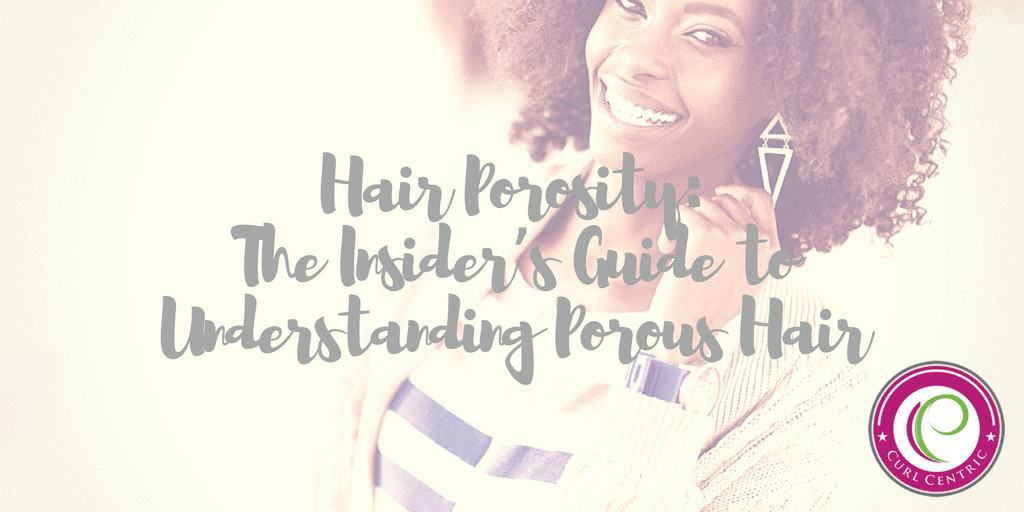
Hair porosity, in scientific terms, means creating pores within the structure of the hair. This definition of porosity also accounts for breaks and cracks as far as measuring whether the hair absorbs more water due to its porosity.
What Is Porosity?
Porosity is the hair’s ability to absorb and retain moisture or chemicals in the hair's cuticle layer and cortex or the lack thereof. It is important to understand that porosity is a form of hair damage.
As your hair ages, the hair's cuticle layers begin to crack, peel, and lift away. So, older hair usually has a higher porosity than newer hair.
The health of your cuticles is a good indicator of your porosity level.
Healthy cuticles lay flat and retain moisture. Unhealthy cuticles do not lay flat and allow moisture to escape, easily causing frizz and excessive dryness.
For most people, the goal is to find that delicate balance between low and high porosity conditions so your hair can thrive. Let's explore why this is the case.
Key Takeaways
- Determine Your Hair Porosity Type: Porosity is about understanding your hair's ability to absorb and retain moisture. However, the float test's validity is questionable. Scientific methods are more accurate but not typically available for home use.
- Identify Signs of Low and High Hair Porosity: Low hair porosity often resists moisture. Your hair might also feel dense or take a long time to dry. In comparison, high hair porosity may absorb too much moisture and feel dry or damaged. Using the right products for your porosity level can help maintain a healthy balance.
- Hair Type and Porosity Relation: Medium porosity hair usually requires the least maintenance. It's often the most desirable for hair porosity level. You can improve moisture retention using leave-ins, deep conditioners, or hair masks.
- Manage Porosity for Healthy Hair: For low hair porosity, opt for lighter oils and heat to enhance absorption. For high hair porosity, heavier creams, and protein treatments help strengthen hair strands.
Table of Contents
- 1 What Is Porosity?
- 2 Common Causes of Porous Hair
- 2.1 1. Periodic Usage of Shampoo, Towels, and Combs
- 2.2 2. Older, Longer Hair Is Generally More Porous
- 2.3 3. Ultraviolet (UV) Radiation Causes Cuticle Damage
- 2.4 4. Certain Chemical Treatments Encourage Porous Hair
- 2.5 5. Other Factors
- 2.6 Can Porosity Be Fixed?
- 2.7 Is It Possible to Open and Close the Hair Cuticles?
- 2.8 Is It Possible to Stop the Hair Cuticle From Being Raised?
- 2.9 Can Apple Cider Vinegar Help Close the Hair Cuticle?
- 2.10 Can Cold Water Assist in Closing the Hair Cuticle?
- 2.11 Can Protein Treatments Assist With Porosity?
- 3 How Do You Determine Your Hair Porosity
- 3.1 Porosity Strand Test
- 3.2 Porosity Float Test
- 3.3 What if the Oil Is Removed Before Performing the Porosity Test?
- 3.4 Does the Temperature of the Water Matter?
- 3.5 Does Water Absorption Cause the Hair to Sink? What if Your Hair Floats?
- 3.6 Is There a Scientific Test for Hair Porosity?
- 3.7 Kira's Thoughts
- 4 Frequently Asked Questions

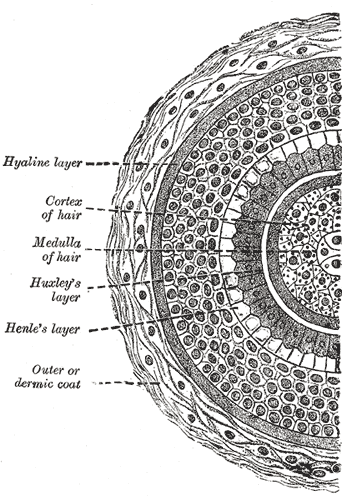
What Is Low Porosity Hair?
Low-porosity hair (flat, tight cuticles) will not absorb moisture as easily as high-porosity hair.
The cuticles are not damaged, but the hair experiences dryness as if the cuticles were damaged.
The hair takes longer to saturate with water, and conditioner may have little to no effect on the hair.
The cuticles are tightly sealed, and it’s more difficult to penetrate them.
While it's true that everyone's hair is different, all hair naturally experiences porosity and permeability. There are many reasons why porosity occurs.
In this article, we'll discuss some of the most common causes and our recommendations to combat typical porosity issues.
Related Articles
- Sealing Oils for Low Porosity Hair
- How to Moisturize Low Porosity Hair Naturally
- Rice Water for Low Porosity Hair
- Best Moisturizer for Low Porosity Hair
What Is High Porosity Hair?
On the other end of the spectrum is high-porosity hair. The cuticle layers have begun to crack, peel, and lift away.
They are probably no longer attached to the strand of the hair, leaving the cortex unprotected. The damaged or missing cuticles are the cause of chronic dryness.
The cuticle is not intact and cannot perform its job, which is to seal shut – retaining the moisture.
With high-porosity hair, the hair absorbs moisture quickly but also loses moisture (or dries out) at an even faster rate.
Related Articles
Dealing With Hair Porosity Problems
The more porous your hair is, the more moisture is usually absorbed. When your hair is highly porous, it will often feel dry. However, it could very well absorb a great deal of water.
You might think, “Great. Now my hair will absorb more moisture!”.
While it’s true that your hair will absorb more water when wet, unfortunately, it will also lose water at a faster rate as it dries. Your hair cuticles cannot adequately retain moisture.
As your hair absorbs water, it expands to accommodate the water. If this process occurs too often, the hair can be damaged due to the amount of stress being placed on it. (source)
What Does Low, Medium, and High Porosity Hair Look Like?
- Low Hair Porosity: Low porosity hair resists moisture and products. It requires light oils like jojoba oil and benefits from heat during treatments.
- Medium Hair Porosity: Medium porosity hair balances moisture retention and absorption. It can handle a broader range of hair products and needs occasional deep conditioning.
- High Hair Porosity: High porosity hair absorbs moisture quickly but struggles to retain it. It benefits from heavier products such as shea butter. It also requires the regular use of deep conditioners and hair masks.
Common Causes of Porous Hair

1. Periodic Usage of Shampoo, Towels, and Combs
Shampooing, towel drying, and combing your hair can damage the cuticle. These techniques are common since most people use them to some extent.
However, high porosity hair is often caused when the hair is scrubbed vigorously with shampoo, rubbed with towels while drying, and when fine-tooth combs are used to remove tangles.
If you're too aggressive while performing these common techniques, you'll potentially cause lots of unnecessary hair damage, leading to higher porosity levels, especially as your hair ages.
2. Older, Longer Hair Is Generally More Porous
Your hair will incur more cuticle damage as it grows longer because it's been shampooed, dried, and combed multiple times over the years.
This hair damage is cumulative, so it increases with time. Read this article to learn more about the best moisturizers for low-porosity hair.

3. Ultraviolet (UV) Radiation Causes Cuticle Damage
Ultraviolet (UV) radiation can also damage your cuticles starting at approximately 200 hours of UV exposure.
Consider wearing a loosely fitting hat with you when you need to be outdoors for an extended period. Also, stay away from tanning lamps and beds.
4. Certain Chemical Treatments Encourage Porous Hair
Certain chemical treatments, like hair bleaching and creamy crack (i.e., hair relaxers), are causes of porosity. Cuticle layers can end up cracking, peeling, and lifting away when these techniques are used.
5. Other Factors
Outside of the above causes, porosity can also be caused by exposure to dirt, flat ironing, blow drying with too much heat, cyclical thermal stresses, and humidity.
It's important to note that everyone's hair is different as well, meaning certain factors will cause more porosity in certain people than others.
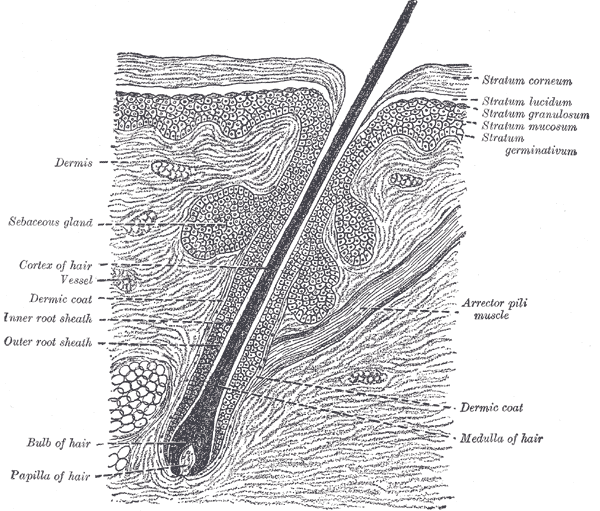
Can Porosity Be Fixed?
When the hair's cuticle becomes damaged, this cannot be fixed. Meanwhile, the cuticles do thin naturally when the hair becomes longer due to normal weathering, but broken, chipped, or missing cuticles cannot be replaced.
It is possible to temporarily patch the hair using hydrolyzed protein; however, you must remember that this is only a temporary solution and not a permanent fix.
Is It Possible to Open and Close the Hair Cuticles?
Note that this is not the manner in which a hair cuticle works. By suggesting that the cuticle opens and closes, you're essentially implying that it operates as a door with a hinge and can be opened without any damage and then closed again.
This is not what happens.
A hair cuticle can be raised to a slight degree; however, this requires highly sensitive instruments for detection as the distance to which it is raised may be as minute as one-millionth of a meter.
It is impossible to feel a raised cuticle by running fingers through the hair unless you have severely damaged cuticles.

Is It Possible to Stop the Hair Cuticle From Being Raised?
The hair cuticle rises when the hair is wet, and people will need to wet their hair and handle it regularly. It is possible, however, to take steps to reduce the amount of damage done to the cuticle.
1. You can use coconut oil as a pre-wash to prevent the hair shaft from swelling. This pre-wash treatment may reduce the extent to which the cuticle is raised.
2. You can use a conditioning shampoo that contains silicones. Silicones help minimize protein loss from the hair caused by chipping and breaking cuticles.
Can Apple Cider Vinegar Help Close the Hair Cuticle?
In the past, we've recommended utilizing a periodic apple cider vinegar (ACV) rinse to treat porous hair by temporarily reducing the porosity level and making the cuticles smooth to increase water retention.
However, we haven't been able to find a case study or scientific evidence that provides substantive proof that the low pH of ACV helps to close the hair cuticle.
It's important to note that an ACV rinse may still help close the cuticle, although it's not likely caused by the low pH based on research.
Products with higher pHs (9 and above), like hair relaxers, can raise the cuticle and potentially destroy it altogether. pH is a common abbreviation for potential hydrogen.
Can Cold Water Assist in Closing the Hair Cuticle?
There doesn't appear to be scientific evidence that supports that cold water can help close the hair cuticles.
It is seen, however, that heat is influential in raising the cuticle, irrespective of the level of heat and the duration of exposure.
Of course, due to the lack of evidence for the impact of cold water on a cuticle, it is not possible to say that cold water does not influence the hair cuticle.
Can Protein Treatments Assist With Porosity?
Yes, they can. As mentioned above, the hydrolyzed protein can be a temporary treatment for damaged hair cuticles, as well as patching up areas where cuticles are missing.
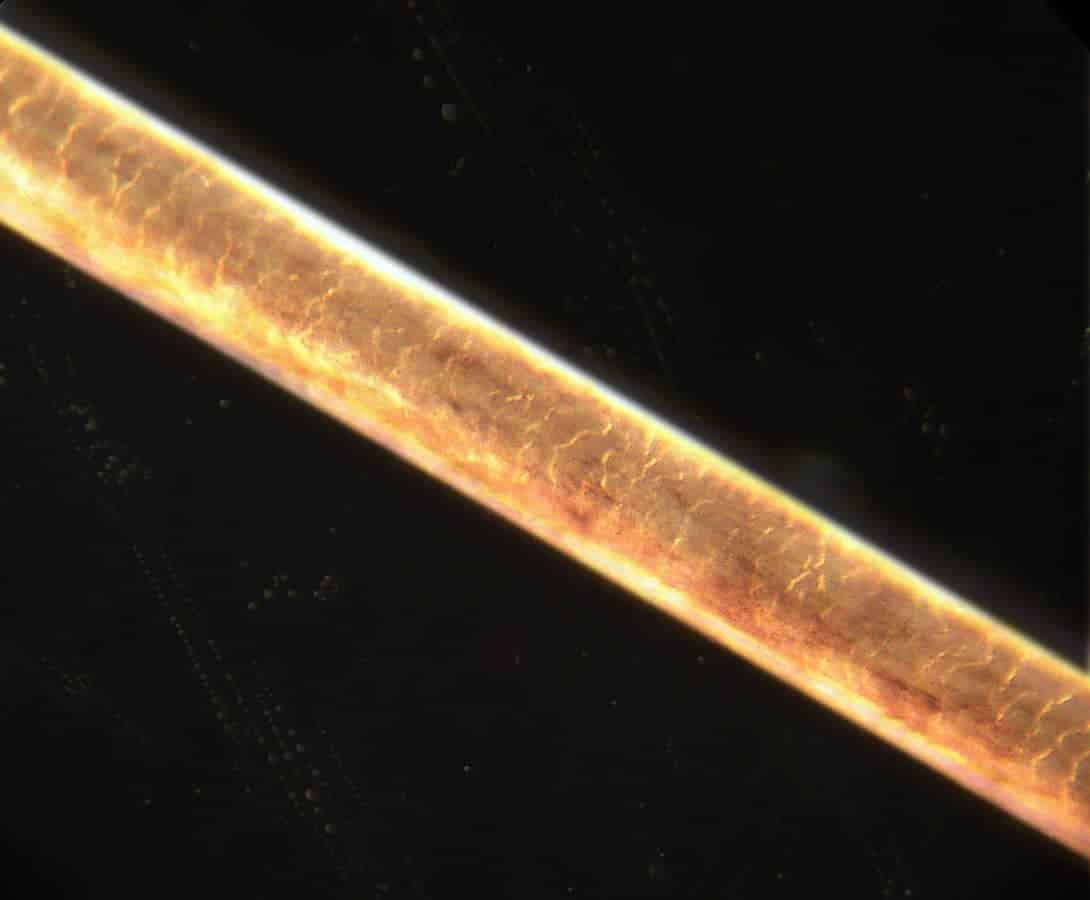
How Do You Determine Your Hair Porosity
You've probably heard that you can test hair porosity in at least two different ways, using the (1) strand test and (2) float test.
Before I explain the potential problems with these DIY hair porosity test methods, it's important to understand how these tests are often conducted.
Porosity Strand Test
Hold a strand of hair between your index finger and thumb. Using your opposite hand, slide your index finger and thumb along the hair strand.
If you feel irregularities that appear to be typical twists, turns, and angles of naturally curly hair, this is normal.
If you feel snags, your hair may be porous. If you don’t feel anything and it’s smooth sailing from tip to root, your porosity is low.
This is a very unscientific process with an extremely low accuracy rate. We don't recommend using the strand test as a reliable determination of your hair's porosity level.
Porosity Float Test
Harvest clean hair from your comb after you shampoo (allow hair to dry). Place the dry hair in a bowl of room temperature water (since cold water will purportedly close the cuticles) to see if it will float or sink to the bottom.
If it sinks, your porosity is high. If it floats, the porosity is low.
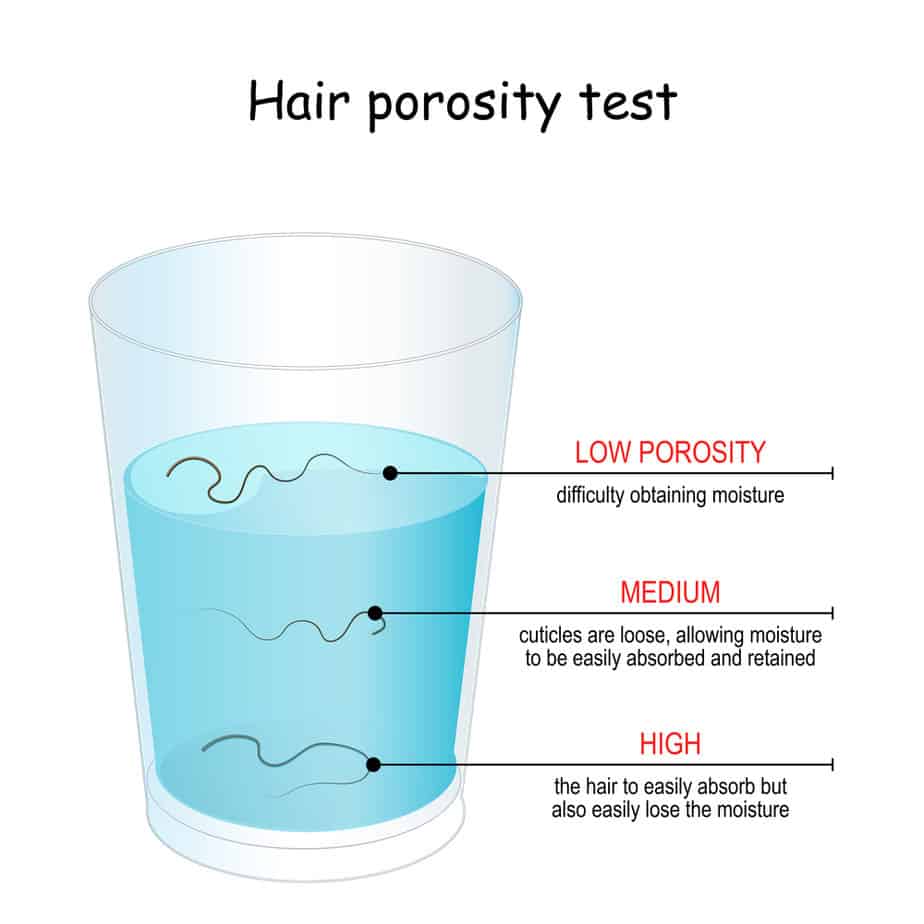
This float test, like the strand test, is unreliable and unscientific as a test for hair porosity. Hair strands will almost always float in water due to the fact that the hair is typically covered in oil.
This oil is the naturally occurring sebum and any other hair products you may choose to include in your hair care routine.
Most people conducting this test report that the hair strands float for a period of time and only sink after some prodding.
Since oil will always float on water, the hair strand will continue floating. This does not necessarily mean the hair has a low level of porosity; it means the hair is light and has a full coating of oil that repels the water.
What if the Oil Is Removed Before Performing the Porosity Test?
If the hair's oil is removed before the test is conducted, would this make the test valid, or would it influence the porosity of the hair strand and the potential for the hair to sink?
If you choose to conduct the float test with a strand of hair that is freshly washed with shampoo but not conditioned, then the test is potentially invalid if you typically use conditioner after shampooing.
In this instance, you would have altered the hair strand that you're testing, making the results of the test questionable.

Does the Temperature of the Water Matter?
Some people claim that the temperature of the water will not influence the result of the porosity test; however, this probably isn't true from a scientific perspective.
We were not able to find scientific evidence that supports that cold water can help close the hair cuticle, but it's unlikely that the water temperature has any impact.
For example, warm water can remove oil from the hair strands. Furthermore, hair is a protein, and most proteins experience small structural changes as temperatures change.
Nonetheless, the most likely result of this test is that a single strand of hair will float.
Does Water Absorption Cause the Hair to Sink? What if Your Hair Floats?
When placing strands of hair in water, the hair strands will absorb water. As more water is absorbed, the hair strands will get heavier.
However, the hair strands may continue to float due to the oil coating.
If your hair sinks, it could be related to hair damage, but it could also be related to the natural density of hair.
This float test is unreliable, so don't interrupt the results as facts.
Is There a Scientific Test for Hair Porosity?
There are scientific tests to determine hair porosity, but they're usually complex and expensive. These aren't the kind of tests that can be reliably conducted at home.
Kira's Thoughts
"I advocate for a nurturing approach that speaks to the unique needs of your strands. Before shampooing, I suggest prepping your hair with a nourishing oil. This prepping process will protect and fortify your hair. Find a sulfate-free shampoo to clean your hair without stripping away natural oils. Then, use a deep conditioner that balances your hair's protein and moisture. Afterward, seal the deal with a water-based moisturizer to optimize hydration levels.
Don't forget your styling choices and environmental exposure affect your hair. It's essential to adopt a regimen that minimizes hair damage. Consistency is the key. A dedicated hair care routine is the cornerstone of maintaining well-hydrated, healthy curls."
Kira Byrd
Frequently Asked Questions
Welcome to our FAQ section. We explain hair porosity so you can understand your hair's unique characteristics. Discover simple solutions to understand and manage your hair's porosity level.
How Do You Know Your Hair Porosity?
To determine your hair porosity, you can perform the float test at home. Alternatively, you can use a more accurate scientific assessment. The float test involves placing a clean strand of hair in water to see if it sinks or floats.
However, this method is mainly unreliable due to various influencing factors. Natural oils, hair damage, and water temperature impact test results. A more precise evaluation can be achieved through professional tests. These tests measure your hair's ability to absorb and hold water. However, these tests are often costly and complex.
What Are Signs of Low Porosity Hair?
Signs of low porosity hair include difficulty with water saturation and absorption. The water tends to bead up on the hair rather than being absorbed. Products often sit on top of the hair instead of penetrating it. There's a general resistance to chemical processes like coloring or perming. Low porosity hair takes longer to dry and might resist conditioning treatments. It also feels less moisturized even after application.
Is Low or High Porosity Hair Better?
Neither low nor high porosity hair is better. They have different needs and characteristics. Low porosity hair can be more challenging to moisturize. However, it often retains moisture well once it's absorbed. High porosity hair absorbs moisture quickly but can also lose it rapidly. The goal is to balance your hair's porosity with appropriate hair care routines. This will allow you to maintain the health and vitality of your hair.
Is Porosity in Hair Good?
Porosity in hair is natural and refers to the hair's capacity to absorb moisture and product. Good porosity is a balance where the hair can absorb the moisture it needs without losing it too quickly. It is beneficial for hair to have a certain level of porosity. However, your hair's porosity type must align with your hair care regimen.
How Can I Improve My Hair Porosity?
For low porosity hair, use heat to help open up the cuticles for better moisture absorption. Then, choose lighter, liquid-based products. For high porosity hair, use leave-in conditioners, oils, and creams to help seal in moisture. Then, protein treatments can temporarily fill in the gaps in the hair cuticles. Regularly trimming your hair can also help manage porosity by removing damaged ends.
What Does Low Porosity Hair Feel Like?
Low porosity hair may feel dense and firm. It has a tight cuticle layer that resists moisture penetration. Products often sit on the surface of the hair. This makes the hair feel coated or filmy without absorbing moisture into the strands. After washing, low porosity hair tends to take a longer time to dry. It might not feel fully moisturized even when heavy products are used.
Final Thoughts
Understanding the porosity of your hair is vital for choosing the right products. Low porosity hair may require lighter oils and heat to aid absorption. High porosity hair requires heavier products such as shea butter and deep conditioners.
Medium porosity hair needs less intervention but can benefit from deep conditioning treatments. Using leave-in conditioners and hair masks can improve your hair's condition. Remember, there's no permanent fix for damaged hair.
With damaged hair, you can only use these tips to patch up the weak spots and manage your problems temporarily.




